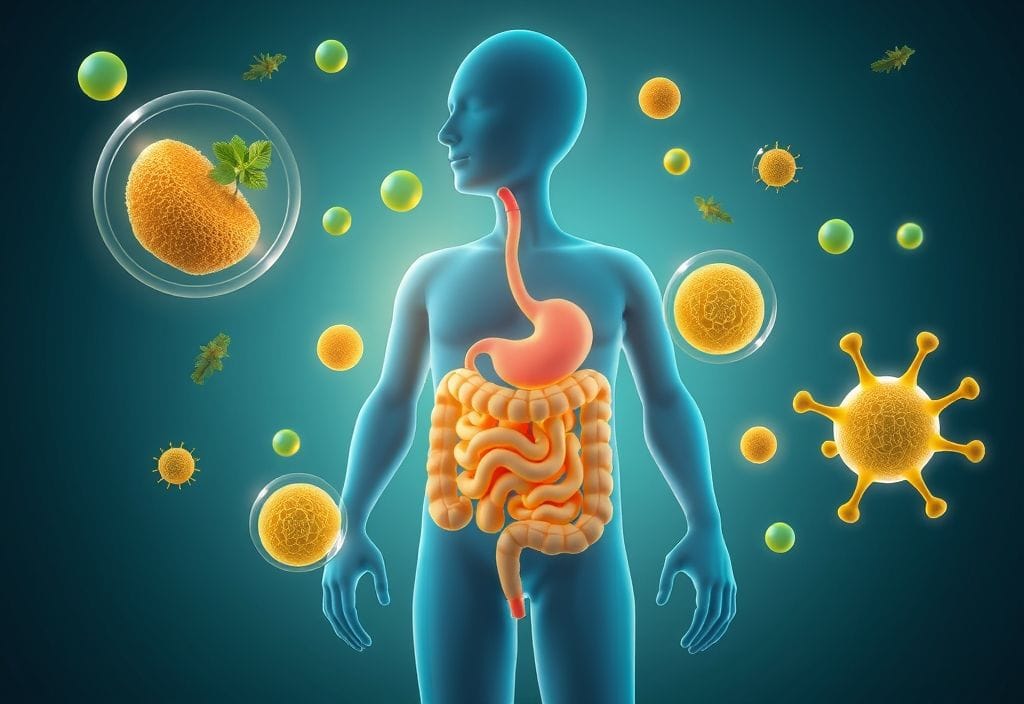Candizi has been a hot topic lately, from the shelves of supplement stores to the headlines of health blogs. It appears promising on paper because it is marketed as a natural solution to common health issues. Is it working, or is it just a fad? What is Candizi? How does it work? What do professionals think? Can you trust it? This guide will cover all of that and more. Is everyone ready to tell the truth from the lies? Okay, let’s get going.
1. Understanding Candizi Beyond the Hype

Candizi are natural chemicals, mostly mixtures of beneficial yeast or botanicals, that enhance microbial balance. This ideology emphasizes supporting the body’s ecosystem above harsh intervention. It’s popular among microbiome-based holistic wellness practitioners as a softer option.
What Exactly is Candizi? Defining the Core Concept
Candizi is not a singular solution. It is a targeted approach that employs specific microorganisms or plant compounds recognized for their ability to create an environment less conducive to the growth of undesirable microbes. It promotes healthy flora and naturally crowds out disruptive ones, much like a competent gardener maintains the sensitive soil of your internal landscape. Its formulations emphasize natural action and synergy.
A Brief History from Traditional Roots to Modern Science
Candizi isn’t based on completely novel concepts. Ayurveda and traditional European herbalism are two examples of ancient medicinal traditions that have long recognized the benefits of fermented foods and certain botanicals for digestive and immune system health. Drawing on this knowledge, current Candizi recipes isolate and scientifically verify the most potent strains and extracts. This connection between modern science and age-old intuition bestows the distinctive legitimacy of Candizi.
Key Ingredients and How They Work Synergistically
Typical Candizi mixes might include strains like Saccharomyces boulardii, known for their strong properties and benefits for the gut, along with ingredients such as oregano oil, caprylic acid, or berberine. These parts work together: the botanicals make an environment that stops the growth of too many microbes that aren’t good for you, and the yeast may help restore balance. Working together makes the effect stronger.
Finding Your Ideal Candizi Format
| Format | Best Suited For | Key Advantage | Considerations |
| Liquid Drops | Quick Absorption Needs | Fast systemic uptake | Taste can be strong |
| Enteric Caps | Sensitive Stomachs | Protects ingredients | Slightly slower act |
| Powder Blend | Adding to Foods/Drinks | Versatile, customizable | Mixing required |
| Topical Cream | Localized Skin Support | Direct application | For external use only |
| Chewable Tab | Convenience & Travel | Easy to take | May contains fillers |
| Prescript-Grade | Specific Health Protocols | Highest potency | Requires consultation |
Safety First: Who Should Approach with Caution?
While generally well-tolerated, Candizi isn’t universal. Key groups needing medical consultation first include:
- Individuals with compromised immune systems
- Pregnant or breastfeeding women
- Those taking immunosuppressant medications
- People with known yeast allergies
- Anyone with severe underlying health conditions
2. The Evidence-Based Benefits of Candizi

Candizi helps maintain the microbiome in balance, alleviates discomfort caused by imbalance, and enhances the body’s natural defenses. The research shows that it increases good bacteria instead of bad ones. People who care about their health adore it because it works in two ways.
Restoring Gut Balance Naturally
Candizi offers the primary advantage of subtly adjusting gut flora. Specific strains in high-quality formulations adhere to the gut lining, forming a protective barrier. This prevents harmful microbes from establishing themselves, enabling beneficial bacteria to thrive.
Boosting Immune Defense Mechanisms
A balanced gut microbiome enhances immune responses. Candizi components enhance the production of secretory IgA, a primary antibody in the immune defense system. Research indicates that this approach diminishes susceptibility to seasonal risks and facilitates faster recovery.
Reducing Digestive Discomfort
Microbial imbalance is frequently the cause of bloating, gas, and irregularity. Candizi promotes effective digestion of nutrition and calms inflamed intestinal linings. After using the product consistently for a few weeks, many consumers report feeling more relaxed.
A Real-World Turnaround
Sarah K., 34, had trouble with exhaustion and upset stomachs that came back again and again for years. After 90 days of following a specific Candizi protocol and using probiotics, her stool tests indicated a 40% drop in indicators that were causing problems. She said that her bloating decreased by an “amazing” 67% and she regained her energy for her kids. Her doctor said her cortisol levels were better, which linked intestinal health to being able to handle stress.
Supporting Skin Clarity from Within
Gut-skin axis research reveals Candizi’s indirect benefit: a balanced microbiome reduces systemic inflammation. This often manifests as calmer skin, fewer breakouts, and reduced redness, proving that true beauty starts internally.
3. Potential Risks and Smart Precautions

Candizi is usually safe, but not always. Medication interactions, transient stomach problems, and rare allergic responses are possible side effects. Understanding these and consulting professionals, especially with pre-existing ailments, is responsible use.
Common Mild Side Effects
When they first start taking Candizi, some people get short-term bloating, gas, or light headaches. This “die-off” reaction occurs when unwanted bacteria become smaller in size. It usually resolves on its own within 3–7 days as the body adjusts to it.
Serious Risks for Vulnerable Groups
Immunocompromised individuals (e.g., undergoing chemo, HIV+) face infection risks from live yeast strains. Those with central venous catheters are particularly vulnerable. Absolute medical clearance is essential here.
Medication Interactions to Watch
- Candizi can modify the effectiveness of specific pharmaceuticals.
- Immunosuppressants may diminish efficacy.
- Antifungals: Risk of Potential Over-Suppression
- Warfarin: Modified absorption
- Diabetes medications may improve the efficacy of glucose reduction.
- Thyroid Hormones: Timing adjustments are frequently required.
The Formulator’s Insight
Dr. Lena Evans, microbiologist and Candizi researcher, shares: “One patient with stubborn SIBO saw genius-level improvement with a staggered Candizi protocol—but only after we ruled out histamine intolerance. Testing first prevents unnecessary frustration. It’s about matching the tool to the terrain.”
Quality Matters: Avoiding Contaminated Products
Not all supplements meet safety standards. Third-party testing (look for NSF/USP seals) is non-negotiable. Reports exist of products containing undeclared allergens or harmful microbes—never gamble with uncertified brands.
4. Your Candizi Roadmap – Choosing Wisely

Selecting the right Candizi product requires scrutinizing ingredients, delivery formats, brand transparency, and your unique health context. Avoid impulse buys—matching formulation to need prevents wasted money and suboptimal results. Focus on synergy, not just star ingredients.
What the Label Reveals About Its Non-Negotiable Ingredients
Put strains with human clinical support, like Saccharomyces boulardii CNCM I-745, at the top of your list. Avoid using fillers such as magnesium stearate or synthetic flow agents. For improved survivability, look for products labeled as “stabilized” or “enteric-coated.” Synbiotic blends, which are a combination of probiotics and prebiotics, often work more effectively than individual probiotics or prebiotics.
Potency & CFU Counts – What’s Meaningful?
Higher CFU (colony-forming units) isn’t automatically better. Research shows 5-10 billion CFU daily often suffices for maintenance. Acute needs may require $15-50 billion, but only in the short term. Shelf-stable strains trump ultra-high counts that degrade.
Red Flags: Spotting Low-Quality Products
Be wary of brands that:
- Lack of third-party testing seals (NSF, USP, Informed Choice)
- Use proprietary blends to hide dosages
- Make dramatic “cure-all” claims
- Have no clear batch testing reports
- Use unclear “other ingredients” lists
Portland’s Secret: Pair with Local Raw Honey
For Oregon readers: Try taking Candizi with a teaspoon of Coast Range wildflower honey—its enzymes boost bioavailability while the subtle pine-resin undertones ease absorption.
Timing and Synergy for Maximizing Effectiveness
For best gut colonization, take Candizi 20 minutes before meals when you are not hungry. For stronger results, take with PHGG fiber prebiotic. Afterward, avoid drinking anything hot, as heat can kill sensitive strains. Unless told otherwise, use in cycles (for example, three months on and one month off).
5. Candizi vs. Alternatives – Making Informed Choices

Knowing where Candizi fits in with other gut-supporting strategies helps you avoid confusion and get the best results. It’s not always a replacement; sometimes it’s a complement. Knowing the differences enables you to make better, more informed choices.
Candizi vs. Traditional Probiotics: Core Differences
Probiotics add beneficial bacteria. Candizi primarily uses yeast strains and botanicals to manage microbial terrain. Think of probiotics as seeding a garden, while Candizi prepares the soil and weeds. They often work best sequentially or together under guidance.
When Prescription Antifungals Are Necessary
Candizi supports balance; prescription antifungals (like fluconazole) aggressively eliminate overgrowths. Use Candizi for maintenance or mild imbalance. Seek prescriptions for severe, systemic, or diagnosed fungal infections—never self-treat these. Some fungal flare-ups are misdiagnosed as simple skin cysts or acne. Understanding the difference between a cyst and a pimple can prevent delays in receiving the right treatment (full guide here).
Herbal Antimicrobials Compared
Berberine and oregano oil function similarly to Candizi botanicals; however, they don’t have the exact yeast strain synergy. Single herbs provide focused, potent activity, while candizi supports the environment more broadly. To prevent tension, combining both calls for professional supervision.
Comparing Microbial Support Strategies
| Approach | Primary Mechanism | Best For | Key Limitations |
| Candizi | Yeast + botanical synergy | Mild-mod imbalance, prevention | Limited for acute infection |
| Rx Antifungals | Pathogen elimination | Severe/confirmed infection | Liver strain, resistance risk |
| Single Herbs | Potent antimicrobial | Targeted pathogen reduction | Gut flora disruption |
| Probiotics | Beneficial bacteria boost | Post-antibiotic recovery, daily support | Less effective alone in dysbiosis |
| Dietary Change | Starve unwanted microbes | Foundational support | Slow; insufficient alone |
| Digestive Enzymes | Improve food breakdown | Malabsorption issues | Doesn’t address root microbes |
Strategic Combinations in a Practitioner’s Playbook
Pairing Candizi after antimicrobial herbs can prevent rebound imbalance. Using it with soil-based probiotics (like B. coagulans) boosts diversity. A “genius move”? Start Candizi 2 weeks after completing the antibiotic course to protect your gains—avoid taking them simultaneously.
The Morning Ritual That Enhances Candizi
The zesty warmth of the Candizi powder promotes circulation, while the polyphenols facilitate its easy absorption in the stomach. Stir the powder into lukewarm ginger tea. Formulas that contain yeast should not contain citrus.
6. Expert Voices – Balanced Perspectives on Candizi

Leading researchers agree that Candizi has a place, but they say it should only be used in certain situations. It’s a tool, not a magic bullet. Experts stress that for long-lasting results, you need to use personalized methods, find reliable sources, and manage your expectations effectively.
What Robust Studies Confirm About the Evidence
Human trials validate S. boulardii for antibiotic-associated diarrhea and C. difficile support. Botanical efficacy (oregano, berberine) is dose-dependent. Full-spectrum Candizi blends need more long-term studies but show promise in clinical practice. According to WebMD, S. boulardii is widely used for managing digestive issues due to its ability to survive stomach acid and support gut flora recovery.
Common Misconceptions Debunked
- “Candizi detoxes the body.” It doesn’t detox; it helps maintain a balance of microbes.
- “Stronger die-off means it’s working “: Bad formulation or wrong fit can cause severe reactions.
- “Safe for unlimited use”: Cycling stops adaptation; use for up to 3 months without supervision.
- “Replaces pharmaceuticals”: adds to, but doesn’t replace, essential medications.
- “One brand fits all “: Different strains work for different people; choose the one that works best for you.
Dr. Arjun Mehta’s Clinical Reality Check
I’ve seen Candizi work wonders for IBS-M patients when paired with low-FODMAP diets. But last month, a patient using an untested brand developed SIFO. Quality and professional guidance aren’t optional—they’re life-saving.
Integrating Candizi into Holistic Wellness
View it as one piece: combine stress management (cortisol disrupts gut balance), fiber-rich foods (which feed good bacteria), and sleep hygiene (gut repair peaks at night). Track symptoms in a journal—not just gut, but energy, skin, mood.
How Future Research Is Shaping Scientific Progress
Ongoing studies are exploring Candizi’s role in metabolic health, mental wellness (via the gut-brain axis), and personalized formulations based on microbiome testing. Next-gen “smart” Candizi may release actives only where an imbalance is detected.
Conclusion: Navigating Your Candizi Journey Wisely
Candizi is an interesting and scientifically sound approach to promoting microbial coexistence, but it’s not a magic pill. Its real power comes from using it innovatively, with good tools, professional help, and as part of a healthy, whole lifestyle.
You can experience benefits like improved digestion, a stronger immune system, and clearer skin, but be aware of its limitations. Avoid the mistakes of self-prescribing or seeking quick fixes.
Work with a practitioner who knows what they’re doing, pay attention to your body, and put facts over hype. Candizi can help you feel healthy and strong from the inside out if you know how to use it right.
Final Thought
The goal of wellness is not to eradicate the “bad” but to cultivate the “good” so that harmony may develop without external interference. At its finest, candizi is more like a gardener’s tender touch than a sword for a warrior.
Your Candizi Questions Answered (FAQs)
Can I take Candizi while pregnant or breastfeeding?
Exercise extreme caution. Fetal/infant safety data is lacking. First, consult your OB/GYN and a prenatal microbiome specialist about hormonal changes and their impact on gut dynamics. Never self-prescribe during this critical time.
How long until I see results?
Two to three weeks may bring relief from bloating and improved regularity. Improvements in immunological resilience and skin clarity take 8-12 weeks of constant use. Weekly symptoms—no change by Week 6? Rethink your formula or causes.
Is Candizi safe for children?
Only under pediatric supervision. Dosing is important—some yeast strains may overstimulate growing immune systems. “Florastor Kids” offers customized formulas, but never replace medical guidance for recurring illnesses or digestive disorders.
What if I experience “die-off” symptoms?
Initial symptoms include flatulence or mild headaches. Take 50% less, drink 2L mineral water daily, add ¼ tsp Celtic salt, and add ginger tea for a genius hack. Stop and explore formula mismatch or deeper dysbiosis if symptoms persist for more than 10 days.
Can I take probiotics with Candizi?
But strategically. Probiotics can be taken 2-4 weeks following a Candizi cycle or at opposite times of day. Watering weeds and seeds in the same soil might neutralize the effects.




